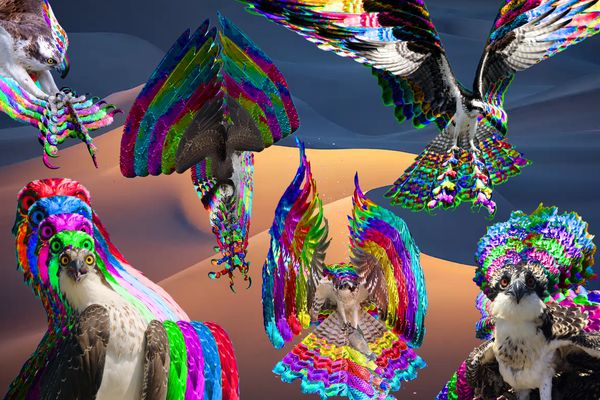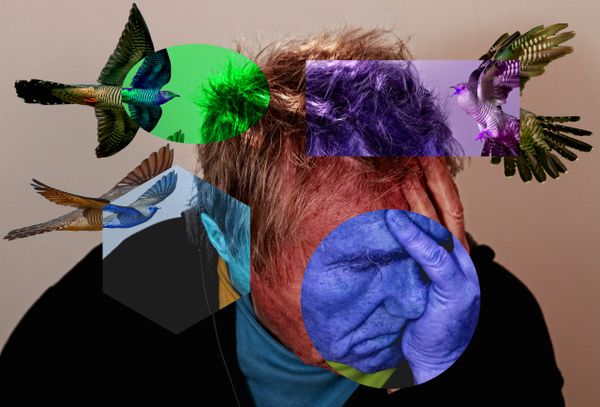“Prison Reform: A Bird’s Eye View” (2025) Page 3

Solitary (Hallucination)
This photomontage, the fourth in the Solitary miniseries, is composed of seven found photos. In this Capstone Project, specific bird species are chosen for their symbolic meaning, but in this piece, Ospreys were selected purely for their striking appearance. Their bright golden eyes and long necks give them an anthropomorphic expression of annoyance or unease. I experimented with layering, scaling, and distorting hue and saturation to create a hallucinogenic effect. The desert sand dunes in the background contrast sharply with the birds’ colors and serve as a symbol of the neurological damage of solitary confinement.

Solitary (Suicide)
This work is the final and most ominous piece in the Solitary miniseries. It is composed of three found photos. The subject matter is sensitive, yet it reflects a harsh reality for inmates, particularly those in solitary confinement, making it essential to include in this series. My goal was to present the piece in a visually palatable way without allowing the viewer to disengage from its message. In the foreground, a building features bird-safe glass, while the cityscape in the background represents the prison’s general population. A river acts as the dividing barrier, symbolizing the isolation of solitary confinement. A Swallow—often associated with hope—is depicted in a deliberate, rapid flight toward the glass, fully aware of its presence and the consequence of hitting it. The sequence halts just before impact, leaving the moment of collision unresolved.

Broken
This piece, created using layering and clipping mask techniques, consists of just two found photos. The focal point is a Spectacled Owl, chosen for its piercing gaze and striking golden eyes, which seamlessly integrate into the fractured glass effect. In the Middle Ages, Owls were seen as symbols of darkness preceding the arrival of Christ and, by extension, were associated with nonbelievers dwelling in that darkness. Here, the owl serves as a powerful metaphor for incarcerated individuals who are left without proper rehabilitation. The shattered glass represents the breaking down of prisoners, who, upon release, are often mere fragments of their former selves—returned to society without the support needed to truly rebuild.

Despair
This piece consists of four found photos and four geometric shapes, blended using adjustments in hue, saturation, and clipping masks. At its center, an elderly man hides his face in shame, evoking a deep sense of sorrow. Surrounding him, Cuckoo birds—often symbolizing grief and despair in Chinese literature—circle his head. His somber expression, paired with the Cuckoos, reflects the profound hopelessness experienced by inmates facing long sentences. The base photo's tone has been intensified with a red hue to symbolize embarrassment and humiliation. In contrast, the surrounding cool tones evoke feelings of depression and sorrow, reflecting the disorientation inmates experience both within prison walls and upon their release.

Isolation
This piece is composed of eight found photographs, carefully collaged to depict a surreal scene in space. Earth is encircled by a variety of bird species, symbolizing life, connection, and diversity. In stark contrast, the Moon is home to a solitary Wood Thrush—often called “The Bird of Solitude”—a creature so deeply tied to seclusion and dense woods that it is more often heard than seen. This celestial setting reflects the vast emotional distance that loneliness and isolation can create. It draws a parallel to the experiences of incarcerated individuals, who endure profound separation from their families during long prison sentences—missing graduations, funerals, weddings, births, and other irreplaceable milestones.

Madness
This work is composed of three found photographs layered with abstract geometric shapes. The background features a cramped, antiquated prison cell containing only a bed and a desk. Colorized shapes have been overlaid, and the entire image has been intentionally distorted, creating a sense of disorientation and ambiguity. In the foreground, a Bald Eagle presents a calm exterior, while a transparent overlay reveals the same eagle mid-scream—symbolizing both suppressed rage and mental instability. This visual duality speaks to the psychological toll of isolation, exploring how confinement can erode the mind and fracture one's sense of self.

Rage Ignited
This piece comprises four found photographs, collaged to depict a man confined in a dark prison cell, with a Shoebill Stork emerging from surrounding flames. The deliberately distorted colors amplify the ominous atmosphere. The Shoebill, known for its intense gaze and formidable presence, symbolizes the suppressed rage that can build within incarcerated individuals. In prison, expressing negative emotions often leads to disciplinary action, compelling inmates to internalize their anger. Over time, this suppression can escalate into profound psychological distress, contributing to long-term mental health issues, including post-traumatic stress disorder (PTSD).

Inside (In) My Mind
This photomontage was created from 8 found photos. Ravens, omens of loss and misfortune, soar as a pensive Black man watches. In his storm-ridden mind, a raptor tears into its prey, marking the hippocampus—the part of the brain that gets damaged by solitary confinement. The contrast between the serene day and his inner turmoil reflects the lasting trauma of incarceration. His race is significant, as Black Americans had the highest U.S. incarceration rate in 2022 (558 per 100,000), though the reasons behind that are beyond this piece’s scope.

Opportunity
This piece was created from eight found photos, a gradient layer, and hand-drawn checkmarks. Former inmates often struggle to find stable employment, which not only hinders their chance at rebuilding their lives but also ripples out across entire communities, deepening cycles of poverty and inequality. Prior convictions make passing background checks difficult, excluding many felons from good paying jobs. A former inmate has served his time and is now free. Limited opportunities prevent him from moving on. Overhead, Albatrosses symbolize the lingering weight of his past, with the largest one emphasizing the word “convicted” on his job application. The prison fences no longer confine him—instead, they bar him from reentering society and opportunities needed to rebuild his life.

Regret
Regret is an emotion often rooted in sorrow for the consequences of one’s actions—particularly those that impact oneself. This photomontage combines three found photographs with two elements generated through AI. At the center, a man gazes forlornly as an Albatross appears to scream at him from behind. Long associated with the burden of regret, the Albatross symbolizes the emotional weight he carries. The horse blinders he wears further emphasize his narrowed perspective: he is consumed not by remorse for the harm he caused others, but by the personal consequences he now endures.
